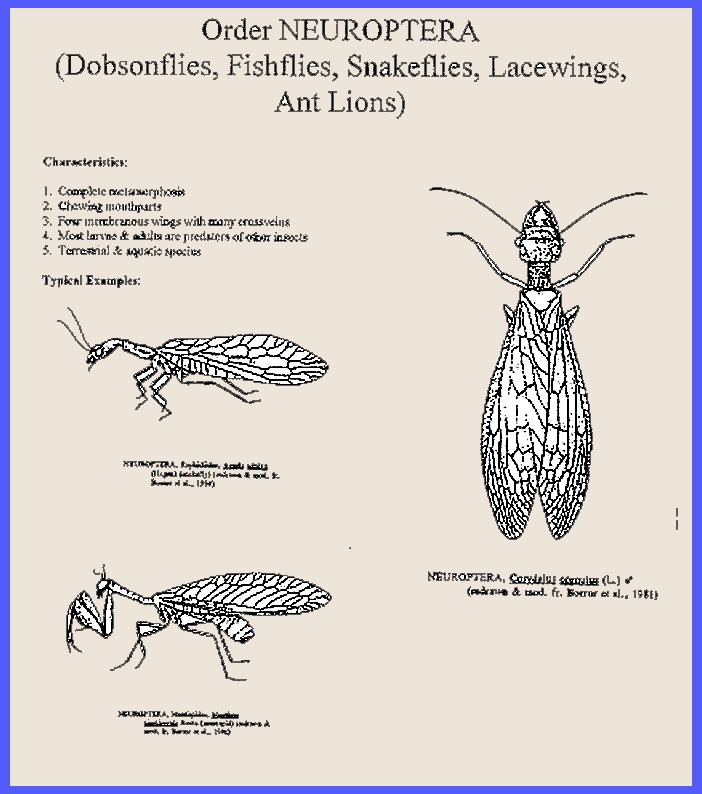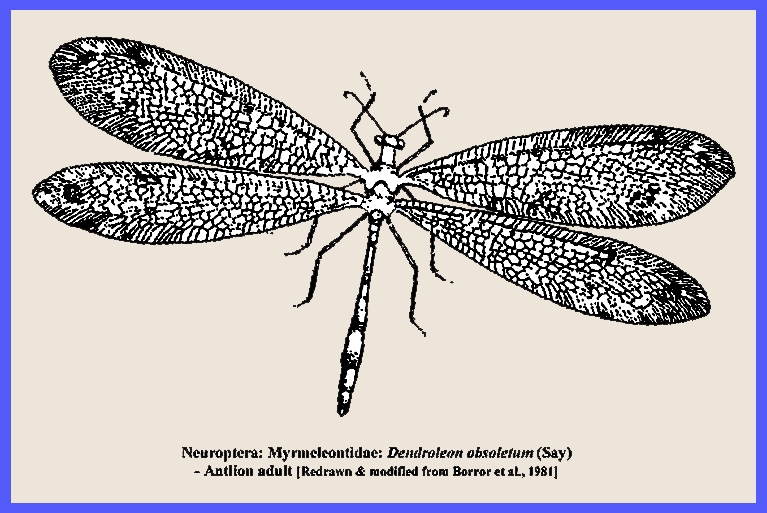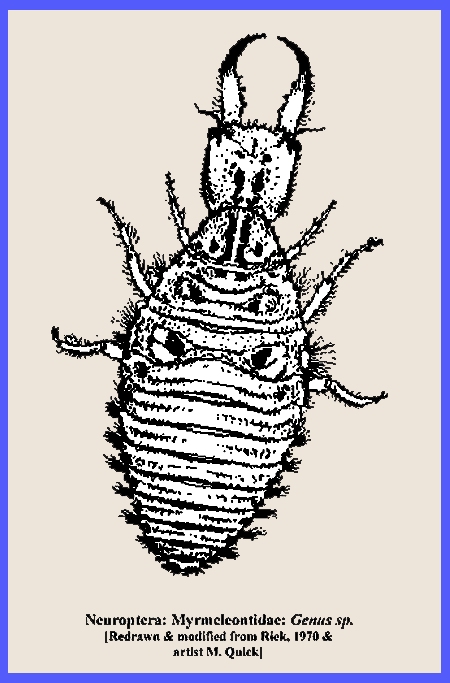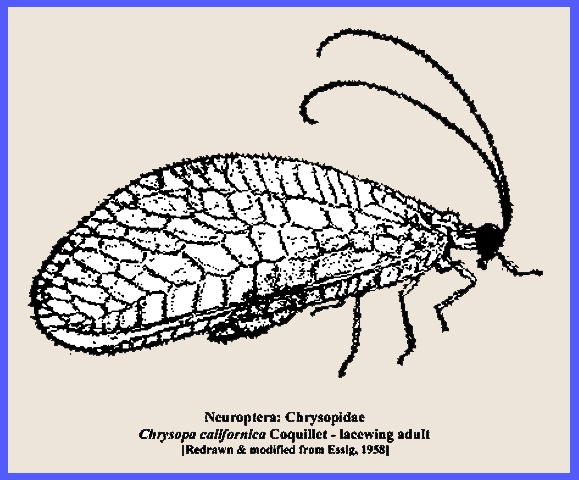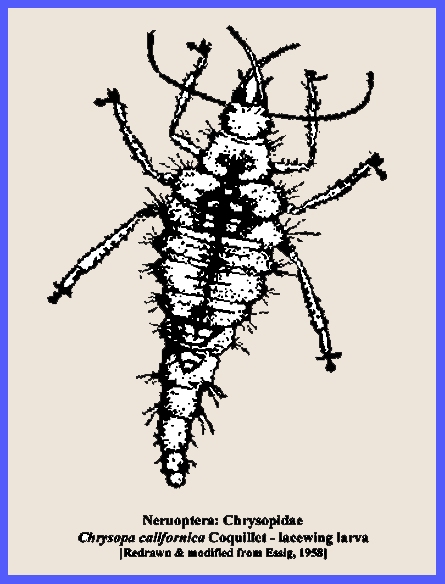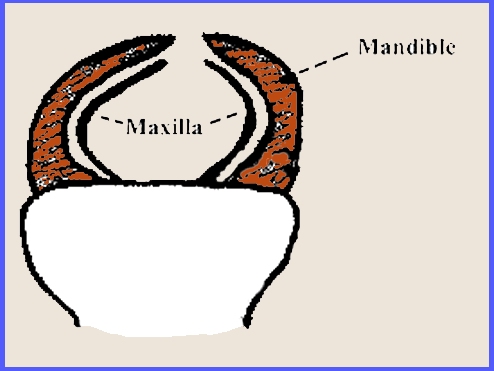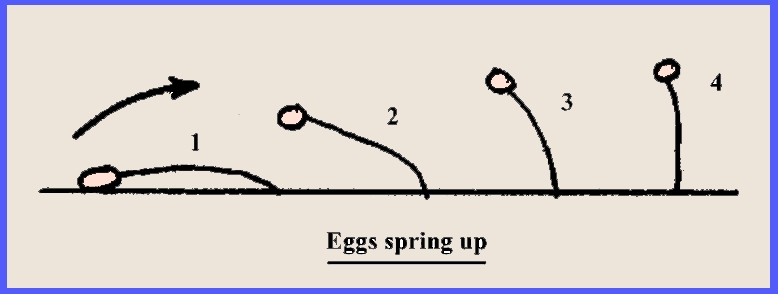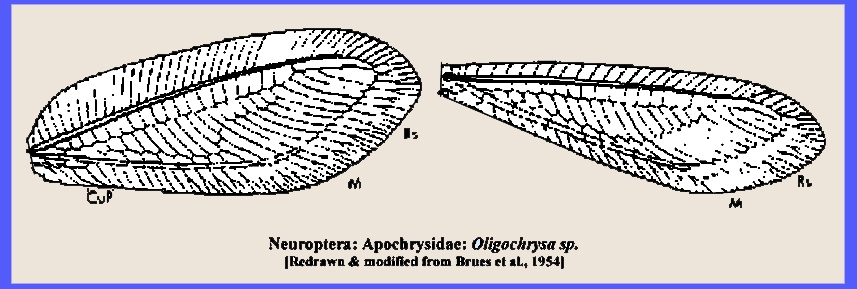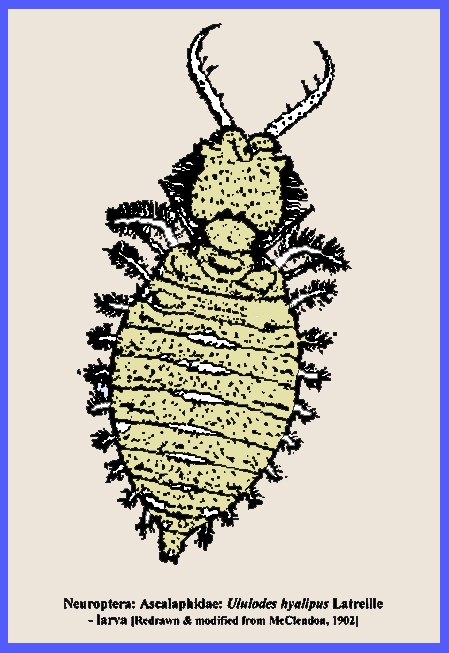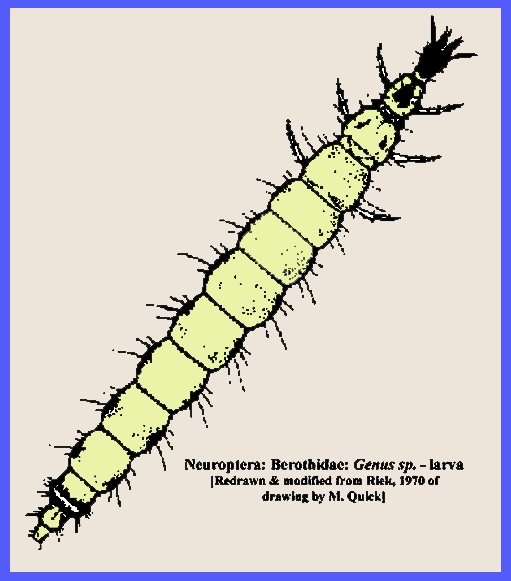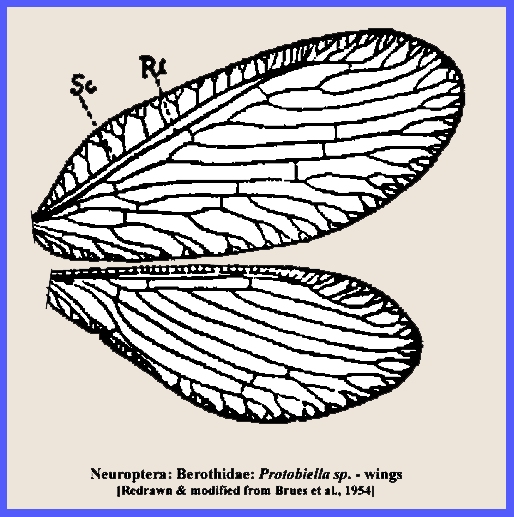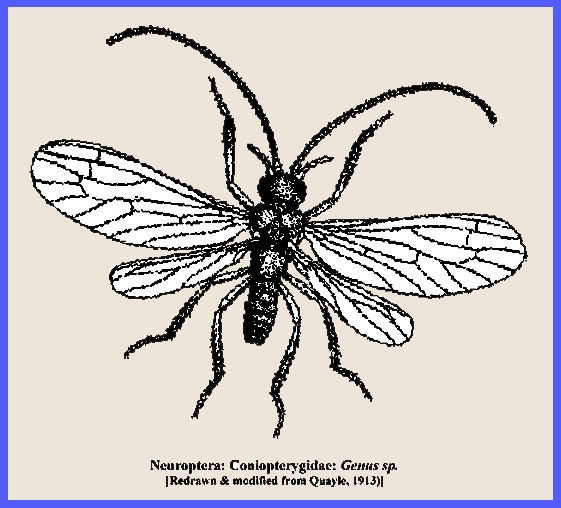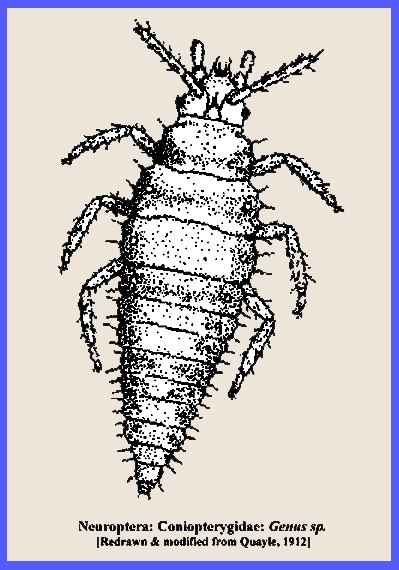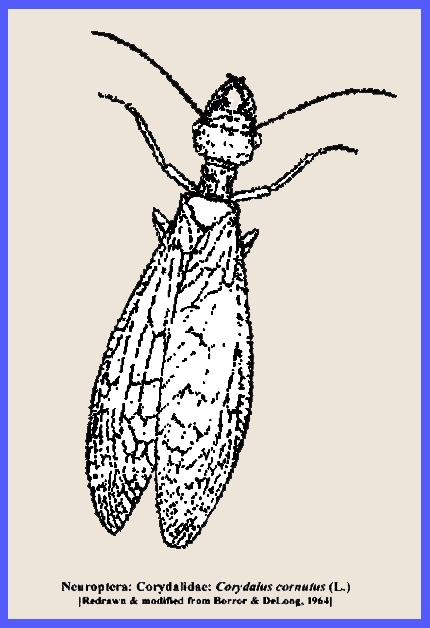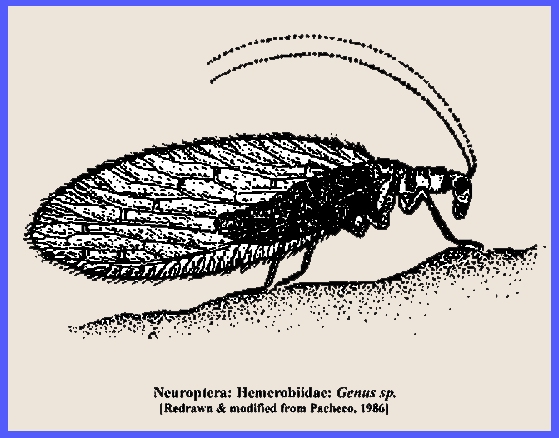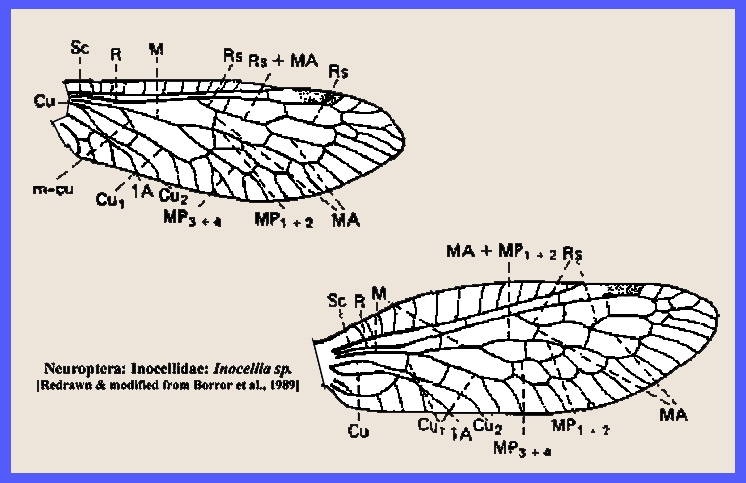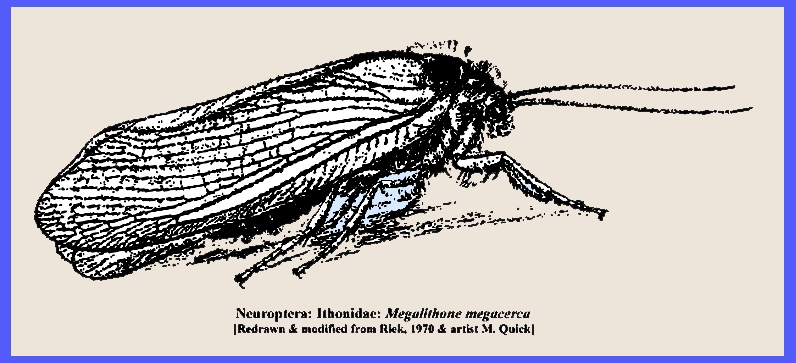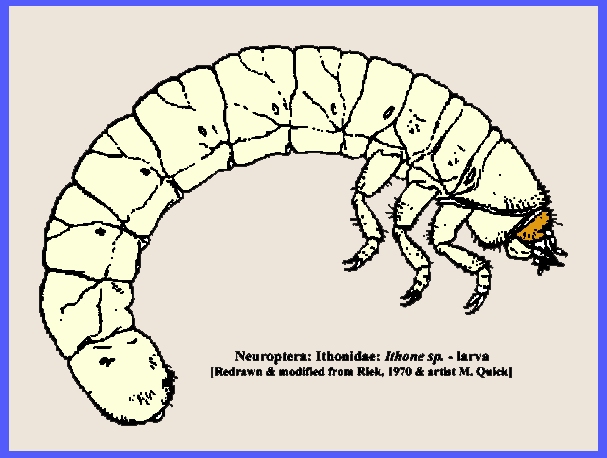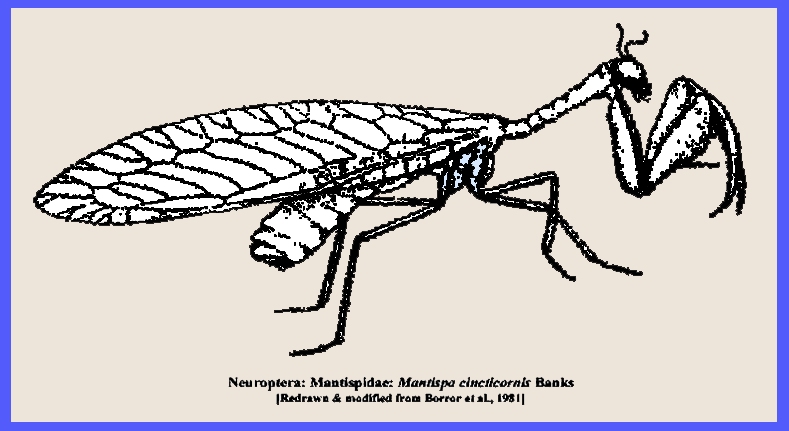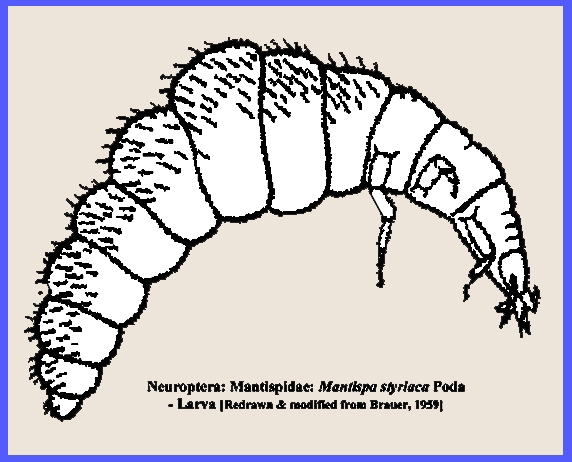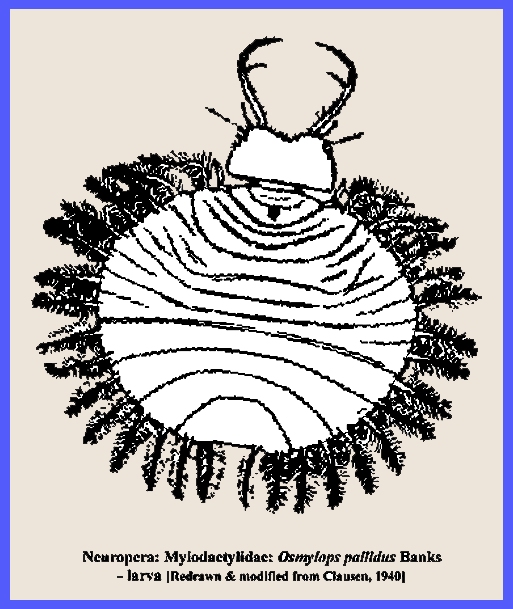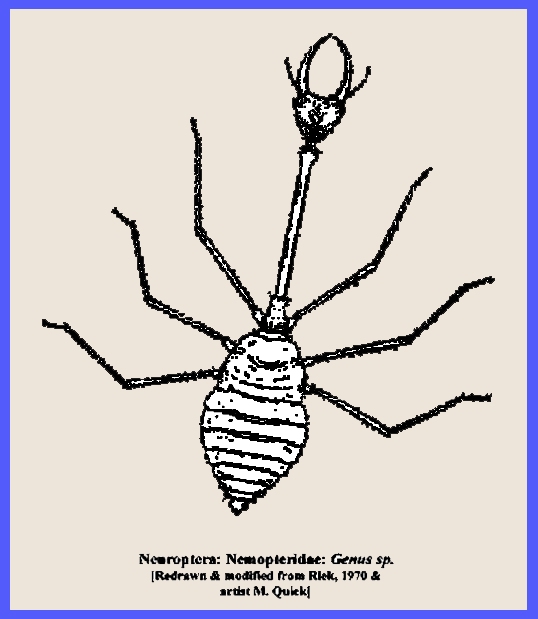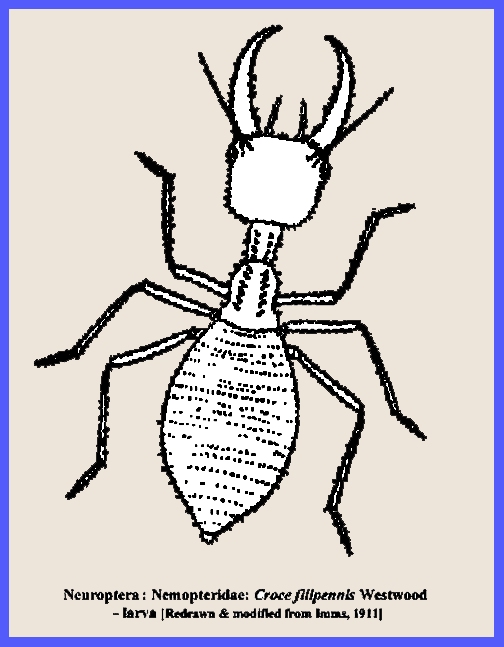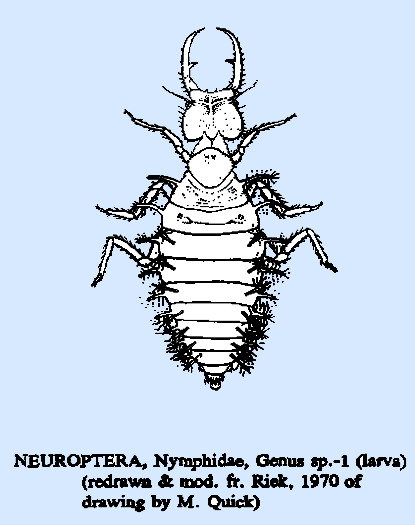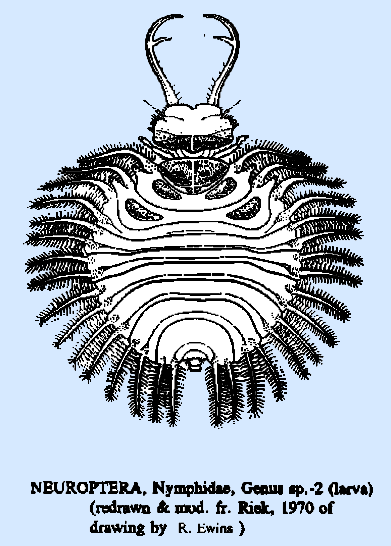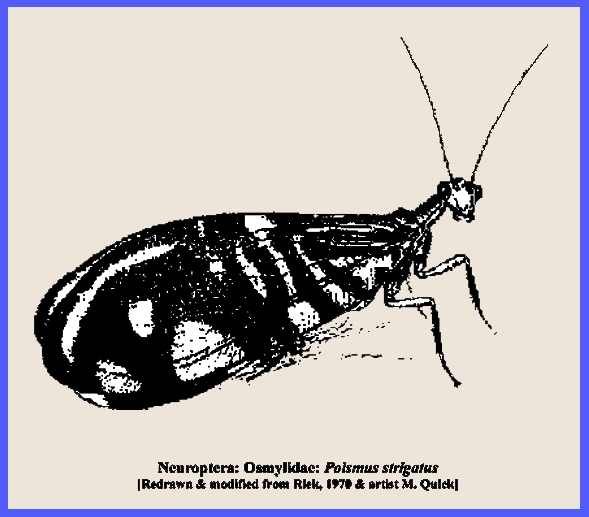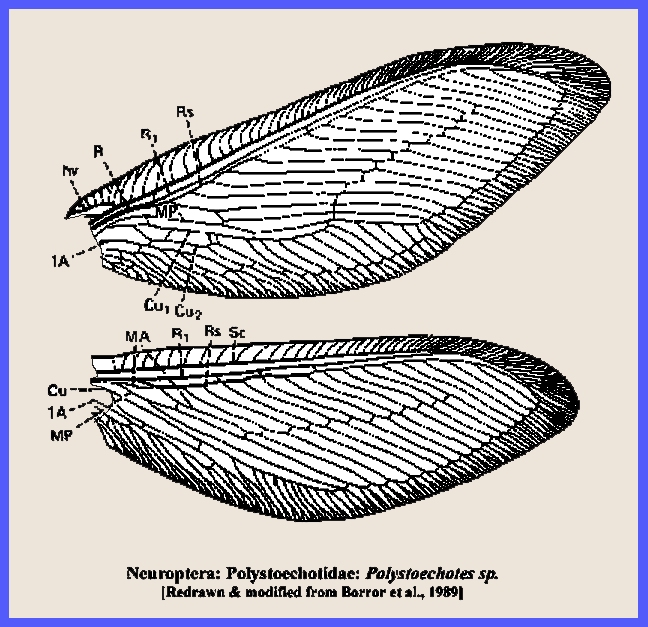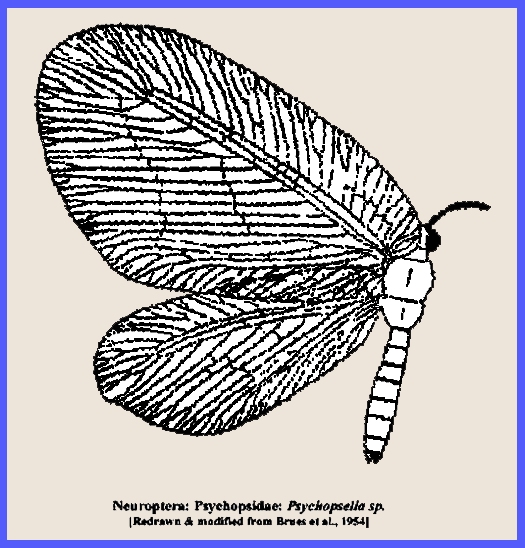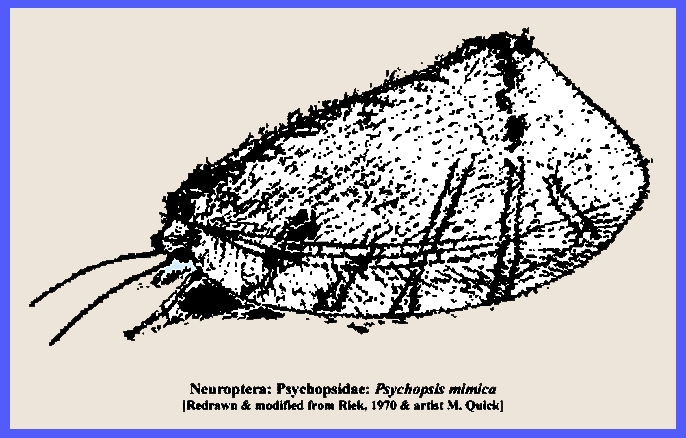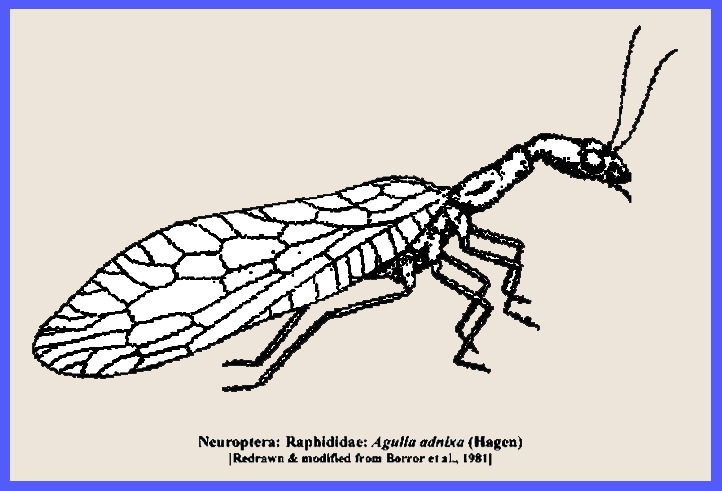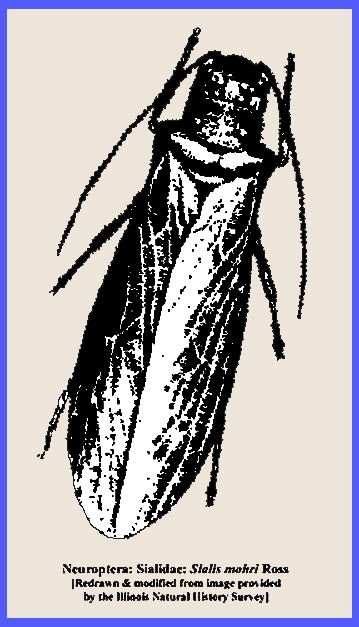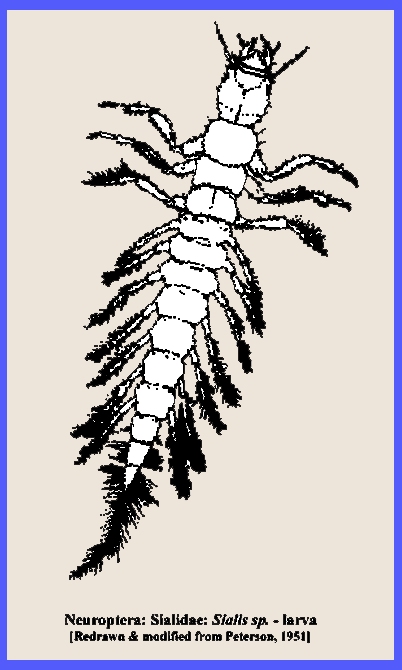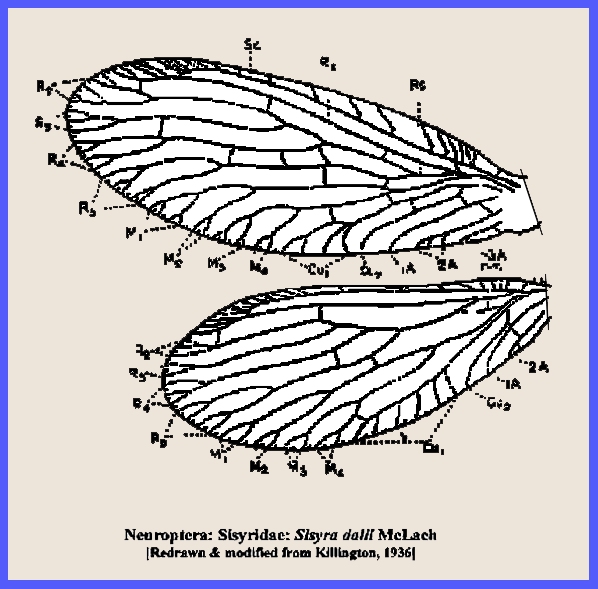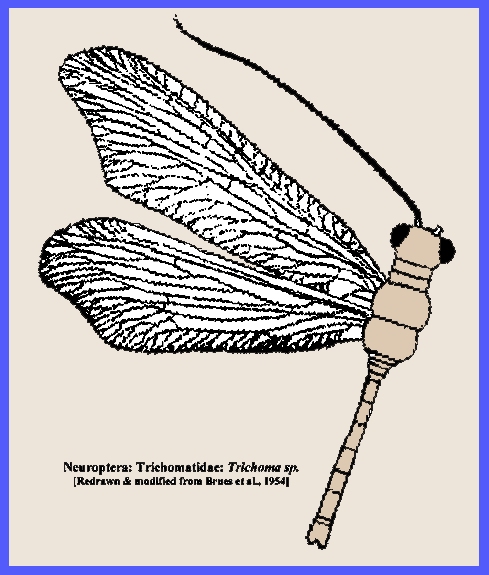File:
<neuroptera.htm> Indexes: < (Entomology),
(Invertebrates), (General Index)> <Invertebrate
Bibliography> <Glossary> <Site Description> < Home>
|
Entomology: NEUROPTERA
1 Kingdom: Animalia, Phylum: Arthropoda Subphylum: Hexapoda: Class: Insecta: Order: Neuroptera (Contact) Please CLICK on underlined
categories to view and on included illustrations to enlarge: Depress
Ctrl/F to search for subject matter:
There are two pairs of large,
broad wings, the posterior ones having a large anal field. The longitudinal
veins branch freely and cross-veins are common, especially behind the
anterior border. A pterostigma or
pigmented area located laterally on the anterior border is either missing or
weakly defined. At rest the wings are held over the back in a roof-like
manner.
Suborder Raphidiodea: are insects of small size. They have two
pairs of similar hyaline wings with freely branching longitudinal veins and a
well-marked pterostigma are characteristic. The head projects forwards and is
flattened above and narrowed toward the prothoracic junction. This, together
with the elongated sub-cylindrical prothorax and the elongated 10th segment
of the abdomen, gives them the name "Snakeflies." The larvae are terrestrial. Raphidia is Northern European. Suborder Planipennia
(Lacewings
and Ant lions): There is a wide
range of form and size in this group, both very large and very small insects
included. There is also much variation in the wings because in some forms,
e.g. Ithone, the two pairs of wings are identical while in others,
e.g. Nemoptera, the posterior ones are elongated to narrow strap-like
structures several times larger than the body. However, all except the small Coniopterygidae agree in having an abundantly branching
venation with many cross-veins. Metamorphosis is complete.
------------------------------------------ The name Neuroptera means,
"nerve-winged." They have complete
metamorphosis and their wings are developed internally. The larvae are either aquatic or
terrestrial, e.g., the Dobsonfly has aquatic larvae
while ant and aphis lions have terrestrial larvae. The larvae have chewing mouthparts
but feed by sucking. They possess a
pincher-like mandible with opposing maxillae. The mandible is grooved, the maxilla acting as a cover. Together they form a food channel that
connects with the mouth cavity. Green lacewing larvae are
important aphid predators. Pupation occurs on land and the
pupae are active. The adult possesses
large mandibles also, while the wing venation is similar to the damselfly
(Odonata). All Neuroptera have
knobbed antennae. Ant lions may
live several years, especially if food is not too plentiful. The adults are either predators or
nonfeeding. Many species are highly
beneficial as predators of destructive insects. The eggs are laid on a stalk
as a protection from predation by other members of the same species. At first the eggs are laid in the prone
position, but they later spring up. Aphis lions are
called "green lacewings" in the adult
stage. There are some modifications
within the order. Some adults possess
raptorial legs. Sialidae larvae have
gills on the abdomen, which are located laterally and are segmented. Neuroptera show some affinities
with other groups such as Coleoptera to which they are closely related. - - - - - - - - - - - - -
- - - - - - - - - - - - - Some of the common families of
Neuroptera are distinguished according to their shapes and habits as follows
(see Borror et al. 1989 for details): Apochrysidae.
-- <Habits>; <Adults> - - - - - - - - - - - - -
- - - - - - - - - - - - - Ascalaphidae. -- <Habits>; <Adults> & <Juveniles>
-- Owl flies resemble dragonflies with long antennae. Ululodes
hyalina Latr. of the southern
United States and Central America was studied by McClendon (1902). Eggs are laid in groups of 57-75 in a
double row at the end of a twig, and the mass is fenced off slightly below
the base by several circles of "repagula" placed on end. These repagula are thought to be aborted
eggs, produced by certain ovarian tubules at the same time that others form
normal eggs. This formation is
thought to protect the egg mass from natural enemies. The incubation period is 9-10 days. Larvae hide in
depression in soil or under the edges of stones and cover their bodies with
sand or dust. While awaiting prey,
the huge mandibles are held widely separated. The closing of the jaws is seemingly triggered by contact, and
the prey is usually paralyzed within seconds by the bite. The body fluids of the prey are absorbed
through a duct formed by the fitting together of curved mandible and
maxilla. There are 3 larval instars, and
development takes ca. 62 days. - - - - - - - - - - - - -
- - - - - - - - - - - - - Berothidae. -- <Habits>; <Adults> Berothidae or beaded lacewings, are a family
of winged insects of the order Neuroptera. The family was first named by
Anton Handlirsch in 1906. Berothidae is very
closely related to the thorny lacewings which are often included in the
Berothidae as subfamily "Rhachiberothinae" but occasionally are
considered the distinct family Rhachiberothidae or included as a subfamily in
the mantidflies. Mantidflies, family Mantispidae, are
another group of rather close relatives, and at least some of the probably
paraphyletic group of fossil forms collectively called
"Mesithonidae" also seem to be quite close. The family consists of 22 genera and 100
living species distributed discontinuously world wide with most being
subtropical to tropical.[1] Eleven
extinct genera with a total of thirteen species have been described from the
fossil record. - - - - - - - - - - - - -
- - - - - - - - - - - - - Chrysopidae. -- <Habits>; <Adults> & <Juveniles> -- Common lacewings green & 2nd largest family in
order. Chrysopids are considered wholly
beneficial and have been used in augmentation release programs against
homopterous pests throughout the world.
A number of species of Chrysopa
were introduced to New Zealand for use in the control of aphid and mealybug
pests and also against Chermidae attacking pines (Clausen 1940/62). Chrysopidae feed on a variety of soft-bodied insects, but mostly
on aphids and mealybugs. Leafhoppers,
thrips, lecaniine Coccidae, mites, etc., may also be attacked. Extensive feeding occurs at intervals on
eggs of Lepidoptera. Larvae of Chrysopa rufilabris Burm. have been found to pierce leaf tissue with the
mandibles in order to feed on larvae of Agromyza
jucunda v.d.W. in their mines. This species is a valuable predator of red
mites on cotton, the larvae consuming an average of 80 per day during the
entire developmental period (Clausen 1940/62). Generally, adults feed on the same insects that serve as prey
for larvae, although their activities in this respect are less. Extended early accounts of the biology and
behavior of Chrysopidae are by Wildermuth (1916), Smith (1921, 1922b) and
Withycombe (1923). Adults usually live 4-6 weeks.
Oviposition occurs the day following emergence from the cocoon and
mating, but occasional species pass the winter as adults and oviposit the
following spring and summer.
Killington (1935) referred to a spermatophore being produced at mating
by Nathanica fulviceps Steph., although Withycombe (1923) did not find
one. The number of eggs laid by the
different species varies, the maximum being recorded by Smith of 617 by a
female of Chrysopa occulata Fitch in 42 days. The general average is thought to be
100-200. Killington (1936) cited
oviposition records, among which are those by Okamoto of 550 eggs from C. nipponensis
Okam. and by Withycombe of 480 eggs from a female of C. phyllochroma Wesm. - - - - - - - - - - - - -
- - - - - - - - - - - - - Coniopterygidae. -- <Habits>; <Adults> & <Juveniles> -- Dusty wings are tiny insects of only 3
mm in length. Both adults and immatures
feed on small, relatively inactive prey such as coccids, mites and
aphids. They are mainly found on
shrubs and trees, although some species seem to be confined to low
vegetation. Adults are active fliers
especially at sunset, when both sexes are attracted to lights. Fontenellea maroccana Carp. & Lest. attacks Orthesia in North Africa and an
undetermined species was observed feeding on Cryptoparlatoria leucaspis
Lind. on cryptomeria in Japan (T. Ishii cited by Clausen, 1940). Withycombe (1923, 1924a) found several
species to be predaceous on Phylloxera,
his observations indicating that the feeding range of the various species is
wide. Conwentzia psociformis
Curt. is associated with oak in England where it feeds on Phylloxera but also on diaspine Coccidae,
red mites, etc (Arrow 1917). Eggs are laid singly on infested foliage. They are oval in outline, flattened
dorsoventrally, and slightly pointed at the micropylar end. The chorion surface bears reticulate
markings. Eggs of C. hageni
Banks are yellowish-pink, although some may have an orange tint (Quayle
1913). Conwentzia psociformis
lays a total of ca. 200 eggs. The number of larval instars was noted as 4 for C. hageni
(Quayle 1913). Larvae of this species
feed on all stages of red mites, the body contents being entirely sucked out
from a single puncture. One larva
consumed 226 red mites during its feeding period. The oval, flattened cocoons of Conwentzia are usually found on the underside of leaves or on
bark. They consist of a double layer
of silk with loosely woven margins.
Cocoons of Semidalis aleyrodiformis Steph. do not have a
clear double layer of silk.
Withycombe (1923, 1924a) found that the pupal skin is often left
within the cocoon rather than discarded after adult emergence. - - - - - - - - - - - - -
- - - - - - - - - - - - - Corydalidae. -- <Habits>; <Adults> Dobson flies &
fish flies are usually longer than 25 mm.
damselflies with long, narrow, many-veined wings and a long slender
abdomen. The family Corydalidae contains megalopterous insects known as
dobsonflies and fishflies. There are about 12 species that occur mainly
throughout the Northern Hemisphere, both temperate and tropical, and South
America. They are large Megaloptera, with a
body usually larger than 25 mm (1 inch). They may have long filamentous
antennae, though in male fishflies they are characteristically feathered.
Ocelli are present; the fourth tarsal segment is cylinder-shaped. The four
large wings are translucent, smoky grey, or mixed, and the anterior pair is
slightly longer than the posterior one.
The eastern dobsonfly, is the most well-known North American species
among the dobsonflies. These genera have distinctive elongated mandibles in
males and form the subfamily Corydalinae. The genera in which the males have
normal mandibles, called fishflies, form the subfamily Chauliodinae. The
summer fishfly, Chauliodes pectinicornis, is perhaps the best-known of
these in North America; its immense mating swarms in the Upper Mississippi
River region fill the air on a few summer nights each year much like mayflies
in certain regions of Europe, leaving millions of carcasses to be cleaned up
the next day. -
- - - - - - - - - - - - - - - - - - - - - - - - -
Dilaridae. -- <Habits>; <Adults> Pleasing
lacewings. Adults resemble small brown moths:
wings rounded, hairy, (and in Nallachius americanus, transparent
except for many light brown spots, a number of which coalesce to form
irregular bands across the wing); costal cross veins of wings not forked; male antennae pectinate; female ovipositor long, recurved
over abdomen. Wing venation:
- - - - - - - - - - - - -
- - - - - - - - - - - - - Hemerobiidae. -- <Habits>; <Adults> & <Juveniles> -- Brown
lacewings. Hemerobiidae are known as
"brown lacewings" and are distributed worldwide. There are around 60 species known in North
America. Diagnostic characters
include forked costal cross-veins, filiform or moniliform antennae and the
forewing having two or more R-s veins.
Hemerobiids resemble chrysopids as far as their predaceous habits
are concerned, but they may be distinguished on the basis of several subtle
characteristics as follows:
Hemerobiid larvae never carry trash as do some chrysopid larvae; the
eggs are not stalked and are attached by their sides to leaves and bark
(Withycombe 1922, 1923). Eggs are
whitish, grayish or even pink and elongate-oval, with the chorion often
pitted. They bear a knob-like or
disk-like micropyle, often of considerable size (Clausen 1940/62). The chorion is densely studded with glossy
papillate projections. The egg
breaker is saw-shaped. Eggs of H. pini
are pale cream colored, that changes to brown before hatching (Clausen
1940/62). - - - - - - - - - - - - - - - - - - - - - - - - - - Inocelliidae. -- <Habits>; <Adults> Small insects with
front wings of 11-17 mm. - - - - - - - - - - - - -
- - - - - - - - - - - - - Ithonidae. -- <Habits>; <Adults> & <Juveniles> -- A rare group with a wingspread
of 35-40 mm. The Australian Ithone fusca Newm. is a predator on various soft-bodied insects,
especially scarab larvae that occur in sandy soil (Tillyard 1922). Clausen (1940) noted that other research
has shown that the larvae are unable to feed on other insects and most likely
obtain food from plant roots. In the
United States the family is rare, being represented by one species, Oliarces clara Banks from southern California. The wingspread of this species is 35-40 mm and it resembles Scialis with bleached wings. Larvae are scarabaeiform and phytophagous. - - - - - - - - - - - - -
- - - - - - - - - - - - -
Mantispidae. -- <Habits>; <Adults> & <Juveniles> (= old Mantidae) -- Mantid flies resemble mantids (Orthoptera). Adult mantispids or
"mantidflies" have large raptorial forelegs, similar to those of
Mantidae, which are for capturing other insects. The larvae are predaceous in the egg sacs of spiders (Mantispa & Climaciella) or on larvae of bees and wasps (Plega). Brauer (1869b)
gave the first and most complete account of one of these species, Mantispa styriaca Poda, that develops in the egg sacs of Lycosidae and
related spiders. Bristowe (1932)
supplemented this account. The eggs
are stalked like those of Chrysopidae and are laid in autumn in clusters on
tree bark, etc., seemingly without relation to the host. Hatching occurs ca. 3 weeks later, and
young larvae hibernate without feeding.
The following spring or early summer, when the spider egg masses have
been laid, they search them out, tearing a hole in the covering to
enter. They then wait until the
spider eggs hatch, after which they feed rapidly and extensively. There is a molt immediately after hatching,
and a second one (the last) after some feeding. The 3rd instar scarabaeiform larvae differ from the active
campodeiform 2nd instar (see Clausen 1940 for diagram).. Its head is small, abdomen very large and
the legs are rudimentary. it is not able
to move in an orderly fashion. The
larva completes feeding and spins its yellow oblong cocoon in which the pupa
is formed within the unbroken larval skin.
After a while the pupa forces its way out of the old larval skin,
cocoon, and the host egg sac, wanders about for a while and eventually casts
its skin to release the adult. - - - - - - - - - - - - -
- - - - - - - - - - - - - Myiodactylidae. -- <Habits>; Adults> & <Juveniles> -- Split-footed
lacewings often included with the
Nymphidae. Clausen (1940)
noted this as a separate family of Neuroptera, with only a few genera and
species that were restricted to the Australian region and some South Pacific
islands. Larvae of Osmylops pallidus Banks are rather circular in
outline, and bear conspicuous mandibles.
They inhabit the underside of eucalyptus leaves where they prey on
other insects (see Clausen 1940 for diagram). - - - - - - - - - - - - - - - - - - - - - - - - - - Myrmeleontidae. -- <Habits>; <Adults> & <Juveniles> -- Ant lions are the largest family in this order. This family includes the well-known ant
lions, named thus because of the habit of larvae feeding mainly on ants and
their ferocious appearance and manner of attack. Larvae are also sometimes called "doodlebugs." The genus Myrmeleon is highly specialized, and because of its cosmopolitan
distribution and abundance, is the dominant group in the Neuroptera with the
possible exception of Chrysopidae.
There are ca. 89 species in North America, being most abundant in the
South and West. Adults resemble
damselflies, with long slender abdomens.
However, they differ in being softer-bodied and having rather long
clubbed antennae and in possessing a different wing venation. They are feeble fliers that are frequently
attracted to lights. The wings are
either clear or irregularly spotted. Reaumur (1742)
published an early detailed account of the behavior of Myrmeleon carius L.,
the accuracy of which was verified by subsequent researchers. Wheeler (1930) provided a review of the
biology and behavior of this species.
The eggs are small, oval in outline, and are laid during autumn in
small groups, adhering end to end, in the sand. Hatching occurs shortly thereafter, and a feeding period occurs
before hibernation. The young ant
lion is slender, with conspicuous mandibles and a tough integument, which is
essential not only for defense but for protection against desiccation. There are several types of setae on the
dorsum which serve to transmit the stimuli from falling sand particles to
indicate the presence of prey in the pit. - - - - - - - - - - - - - - - - - - - - - - - - - -
Nemopteridae. -- <Habits>; <Adults> & <Juveniles> -- Generally included in the Nymphidae. Clausen (1940) noted this as a separate family of Neuroptera,
with just a few species that are closely related morphologically to
Myrmeleontidae. Very long and narrow
hind wings distinguish adults. Larvae
show a decided constriction between the head and thorax, which reaches its
greatest development in the grotesque Necrophylus
arenarius Roux, a species occurring
in the tombs of Egypt and under ledges along the Nile. The neck is very slender and as long as
the rest of the body. Larvae live in
the dust on the floors of caves, in neglected buildings and in other sheltered
spots. Croce filipennis Westw. (Ghosh 1910,
Imms 1911) lives in abandoned buildings where the larvae prey on passing
insects, especially Dermestidae and Psocidae, the latter of which is probably
preferred. The eggs are oval and the
cocoons spherical, both of which are also found in the dust on the
floor. The life cycle is one year, of
which the egg and pupal stages take 10-12 and 18-22 days, respectively. - - - - - - - - - - - - - - - - - - - - - - - - - - Nymphidae. -- <Habits>; <Adults> & <Juveniles> -- Split-footed
lacewings. Clausen (1940) noted this as a separate family of
Neuroptera. Nymphus myrmeleonides
Leach is found in Australia and certain islands of the South Pacific. Larvae are found under debris, each
covered so that only the front of the head and the mandibles are
exposed. They are believed to prey on
wood ants, which are common in their environment. They form a spherical, parchment-like cocoon (Clausen 1940/62). - - - - - - - - - - - - - - - - - - - - - - - - - - Osmylidae. -- <Habits>; <Adults> & <Juveniles> -- A small family of Giant lacewings. Clausen (1940) noted this as a separate
family of Neuroptera, with only a few species, the adults of which are
relatively small. Withycombe (1923)
and Killington (1936) gave detailed accounts of Osmylus fulvicephalus
Scop. The larvae are amphibious and
probe in mud with their long, slender mandibles for Chironomus spp. larvae and other Diptera inhabiting the wet,
mossy borders of streams, etc. Eggs
are elongate-oval, somewhat flattened, with the chorion bearing reticulate
markings. The micropyle is
knob-like. They are laid in rows on
some object near the water's edge.
hatching occurs in ca. 22 days, and larvae mature the following
spring. The cocoon is formed in damp
moss, and adults emerge 10-12 days after. - - - - - - - - - - - - -
- - - - - - - - - - - - - Polystoechotidae. -- <Habits>; <Adults> Giant lacewings with a wing spread of
40-75 mm. Generally included in the
Ithonidae. - - - - - - - - - - - - - - - - - - - - - - - - - - Psychopsidae. -- <Habits>; <Adults> & <Juveniles> -- Silky lacewings. Clausen (1940) noted this as a separate
family of Neuroptera with little known habits. Psychopsis elegans Guer. was studied by Tillyard
(1918). The larvae are predaceous on
various insects occurring on trunks and branches of Eucalyptus and related trees.
Oval eggs are laid in small groups on bark during midsummer. Larvae feed for long intervals, and thus
the period of development extends over two seasons. Egg incubation requires 12 days, and hibernation occurs in the
1st larval instar. The second winter
is passed in the 3rd instar after feeding is completed. Cocoons resemble those of Chrysopa, and are found in bark
crevices. They spend ca. 3 weeks in
the cocoon stage. - - - - - - - - - - - - - - - - - - - - - - - - - -
Raphidiidae. -- <Habits>; <Adults> & <Juveniles> -- The front wing length varies from 6-17 mm. Carpenter (1936) gave an early review
regarding the behavior of raphidids, most of which were European
species. Adults of Raphidia notata F. were found to feed readily on aphids in the
laboratory. Larger insects such as
flies and beetle larvae were attacked only after they had been injured and
were thus unable to put up a defense.
Adult Agulla unicolor Carp. fed on freshly killed
Chironomidae. They showed a definite
cannibalistic tendency also. Raphidiidae is a
small family with less than 100 described species. There are 17 species of Raphidia
known in North America. They are
mainly palearctic in distribution, but are found on all continents except
Australia. Important characters of
these "snake flies" include an elongated prothorax with forelegs at
the posterior end; front legs not raptorial; forewing R-s with more than two
branches; ocelli are absent; ovipositor is exserted and antennae are setiform. The wings of adults vary from 6-17 mm
long, and females are somewhat larger than males. - - - - - - - - - - - - -
- - - - - - - - - - - - -
Sialidae. -- <Habits>; <Adults> & <Juveniles> -- Alder flies, which are dark
colored and about 25 mm. long. The
alderflies are a small family and the larvae of Sialis and several other genera are entirely aquatic feeding
partly on other aquatic insects and smaller animals in their
environment. Adults are dark, ca. 25
mm. max. long. The eggs are laid in masses
on vegetation over or near water. The
larvae differ from the Corydalidae by having a terminal filament, seven pairs
of lateral filaments and no hooked anal prolegs. Sialids have not
been used in biological pest control, but are certainly important in the
natural control of insects in aquatic habitats. - - - - - - - - - - - - -
- - - - - - - - - - - - -
Sisyridae. -- <Habits>; <Adults> & <Juveniles> -- Spongilla flies appear as
brownish lacewings. This is a small
family of "spongillaflies" with just a few genera and species. There are 6 species in North America,
three each in genera Climacia and Sisyra. The Rs vein in the former has a single fork while the latter
has 2 forks located proximad of the pterostigma. Larvae of Sisyra fuscata F. are entirely aquatic,
sucking the body fluids of fresh-water sponges. The larvae are distinguished by having paired, jointed gills on
the venter of the first 7 abdominal segments. Eggs are laid in clusters that are covered with a web of white
silk, on foliage or other objects hanging over the water (Clausen 1940/62). -
- - - - - - - - - - - - - - - - - - - - - - - - -
Stilbopterygidae. -- <Habits>; <Adults> Indecisive group
related to the Myrmeleontidae.
- - - - - - - - - - - - -
- - - - - - - - - - - - - Sympherobiidae. -- <Habits>; <Adults> Indecisive group of Neuroptera.
- - - - - - - - - - - - - - - - - - - - - - - - - - Trichomatidae. -- <Habits>; <Adults> Generally
considered a subfamily of Berothidae - - - - - - - - - - - - - - - - - - - - - - - - - -
==============
|
|||||||
|
|
